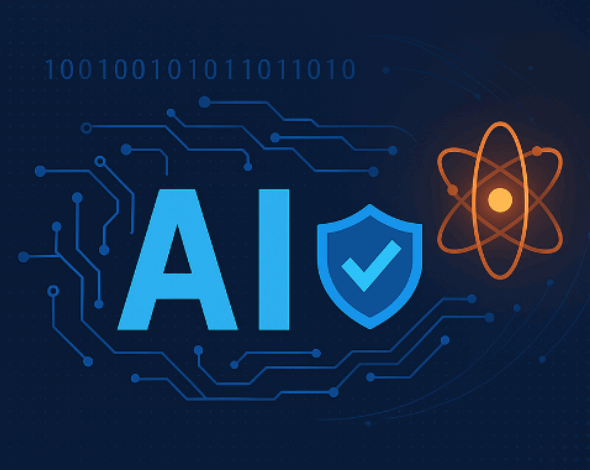
In a digital world moving at machine speed, cybersecurity must evolve—or fail. The threats we face today are not only more frequent but also smarter, stealthier, and increasingly automated. Deepfake scams, AI-generated malware, and quantum computing loom on the horizon, while traditional defenses are not built for that scale of threat.
The solution? A new generation of cybersecurity, powered by artificial intelligence, built on explainability, and fortified for a quantum future.
This article explores three critical shifts in cyber defense:
- Using AI to detect and counter advanced threats
- Making AI in cybersecurity transparent and trustworthy
- Preparing for quantum threats with quantum-safe AI algorithms
Let’s unpack how each one is shaping the next era of cyber resilience.
-
AI Against AI: Defending Against Sophisticated Threats
Cybercriminals have adopted AI—and they’re using it to have a devastating effect.
Natural language models now write phishing emails. Deepfake impersonations of CEOs are fooling employees into wire transfers. Malware can morph on the fly, evading traditional antivirus signatures. And these attacks are scaling globally, rapidly, and inexpensively.
In 2024, a global enterprise lost over $25 million when a deepfake video call convinced staff to authorize a fraudulent payment. The attackers used voice cloning, AI-generated video, and spoofed emails to build a credible fake.
This is the new threat landscape. And AI is the only viable way to keep up.
Defensive AI: Fighting Smart with Smart
Modern cybersecurity platforms use AI and machine learning to match known attack signatures and detect behavioral anomalies—the subtle signs that something’s off.
Take platforms like Sentinel One or CrowdStrike. They detect malware not by name, but by intent:
- Is a user accessing files in a suspicious pattern?
- Is a process modifying critical system files unusually fast?
- Is a known application behaving like ransomware?
Traditional tools often ignore these behavioral indicators. But AI systems that learn normal baselines can spot deviations instantly and act.
Advanced Defensive Use Cases
- Deepfake Detection: Tools like Intel’s FakeCatcher analyze facial blood flow patterns to detect AI-generated videos.
- Self-Healing Networks: AI-enabled infrastructure can automatically roll back to a safe state if a breach is detected.
- AI Honeypots: Dynamic decoys adapt in real-time, drawing in attackers and feeding threat intel back into the defense system.
In modern microservices and hybrid architectures, as discussed in our technical framework, these AI modules can be deployed independently, updated quickly, and scaled with agility. The result is a decentralized yet tightly coordinated line of defense.
-
Explainable AI: Bringing Clarity to Machine-Led Security
AI’s greatest strength is automation. But automation without transparency can be dangerous, especially in cybersecurity.
When an AI system flags a threat but can’t explain why, it puts human analysts in a bind. Do they trust the black-box decision and act? Or dismiss it and risk ignoring a real threat?
In cybersecurity, why matters as much as what.
What Is Explainable AI (XAI)?
Explainable AI is designed to show its work. Instead of just making a decision, it highlights the input, logic, and reasoning behind the conclusion.
This isn’t just a convenience, it’s essential for:
- Validating real threats
- Auditing decisions for compliance
- Improving model accuracy over time
Consider an alert that says: “Suspicious file activity detected.” That’s not helpful. But if it adds:
“Unusual access pattern to critical directories from an unmanaged device, behavior inconsistent with the user’s baseline activity.”
now you’re working with context.
Benefits of Explainable AI in Security
- Faster Decision-Making: Analysts spend less time second-guessing and more time resolving.
- Reduced False Positives: Teams trust the system—and its conclusions.
- Regulatory Compliance: Industries like healthcare, defense, and finance need audit trails that justify actions.
- Improved AI: Understanding errors leads to better model tuning.
Google’s AutoML and IBM’s Watson for Cybersecurity already use natural language output to help explain alerts. But the trend is growing: XAI is quickly becoming a benchmark for enterprise-ready AI systems.
In Distributed Architectures, Clarity Is Everything
In hybrid environments, where data flows between on-prem systems, edge devices, cloud apps, AI’s ability to explain anomalies becomes even more critical.
Without it, security teams face a flood of noise and uncertainty. With it, they get clear, actionable insights—even from noisy environments.
-
Quantum-Safe AI: Building Cybersecurity for the Post-Quantum Era
Quantum computing might still be a few years away from breaking the internet, but cybersecurity must be prepared now.
Why? Because quantum computers could one day crack today’s encryption algorithms—like RSA, DSA, and ECC—in minutes. Any encrypted data stolen today could be decrypted once quantum power arrives.
This is known as the “Harvest Now, Decrypt Later” threat that is already happening.
What Is Quantum-Safe AI?
Quantum-safe AI means more than just upgrading encryption. It means redesigning the entire AI-powered cybersecurity stack to survive in a post-quantum world.
Here’s what that looks like:
- Quantum-Resistant Encryption: AI systems must use protocols like CRYSTALS-Kyber or Falcon to protect data and communications.
- AI-Powered Cryptographic Discovery: Tools that scan your architecture and detect where outdated crypto is still in use.
- Post-Quantum Federated Learning: AI models can still train across distributed, private datasets without centralizing or exposing data.
Your technical paper promotes microservices and hybrid environments—perfect foundations for this shift. But those environments also introduce risk. AI models need to be able to switch between encryption schemes, validate secure communications continuously, and detect if any part of the system is lagging in the post-quantum transition.
Preparing Now for Quantum Resilience
To get ahead of Q-Day:
- Inventory Cryptographic Dependencies: Map of which parts of your system rely on vulnerable algorithms.
- Adopt Dual-Mode Systems: Run classical and quantum-safe encryption side-by-side during migration.
- Use Modular Cryptographic Libraries: Ensure AI systems can upgrade their encryption stack without complete redeployment.
Quantum-safe AI isn’t just theoretical, it’s inevitable. The sooner organizations begin this transition, the fewer disruptions they’ll face when quantum capability becomes mainstream.
Final Thoughts: AI, Transparency, and Quantum Safety Are Non-Negotiable
Cybersecurity used to focus on building walls. Now, it emphasizes creating smart, adaptive systems that can see over the walls, analyze behavior, and instantly adapt to new forms of attack.
To do that, organizations need:
- AI capable of matching AI-powered threats
- Explainability that builds trust in automation
- Quantum safety that future-proofs today’s architecture
Defenders who embrace this triad of smart AI, transparent systems, and quantum readiness will not only survive but also lead the next decade.





